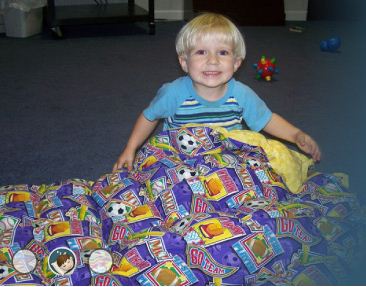OT Corner: Weighted Blankets – The Solution to a Good Night’s Sleep?
By: Anne Zachry, PhD, OTR/L
Have you ever felt a sense of relaxation when someone gives you a big hug? Sleeping under a weighted blanket is like getting a big, warm hug all night long. Weighted blankets provide deep pressure/proprioceptive input to an individual’s joints, muscles, and bones. In many cases, the input is calming and leads to improved sleep. Weighted blankets have been used successfully with individuals who have sensory processing disorders.
When selecting a weighted blanket for a client with sensory processing issues, the treating therapist should carefully consider the client’s specific sensory needs. There are no “official” research-based guidelines for selecting the weight and size of a blanket, but based on feedback from occupational therapy practitioners, 10% of the individual’s body weight is often effective when using weighted vests or lap pads. The treating therapist may want to start with 5 to 8% and make adjustments based on the reactions and/or feedback from the individual. If the client is nonverbal, it may be necessary to get feedback from the parents. For safety reasons, it is critical that the user be physically capable of independently removing the blanket. Most importantly, a weighted blanket should never be used for restraint purposes. If the user does not like the sensation of the blanket, use of the blanket should not be forced.
The blanket should fit evenly on top of the mattress so that no weights are hanging over the edge of the bed. This could cause the pressure provided by the blanket to be uneven. The blanket should NEVER cover the individual’s head, and parents should always provide supervision when using a weighted blanket with their child.
The effects of weighted blankets vary. Many parents have reported that the first night of use resulted in a good nights sleep for their child. However, it may take two to three nights to observe improvements in sleep. If no changes are noted at that point, the treating therapist may want to consider increasing the blanket’s weight. As stated previously, there is no evidence-based research on weighted blankets, but anecdotal reports from therapists and clients are generally positive. For someone with a disorganized nervous system, a weighted blanket may be the perfect solution for a good night’s sleep.
Featured Contributor: Dr. Anne Zachry, OTR/L PhD
Dr. Anne Zachry is a pediatric occupational therapist with over 18 years experience providing quality OT to children, along with caregiver instruction and support. She has a PhD in Educational Psychology. She’s had articles published in her profession’s trade magazine and in peer-reviewed journals. She is currently employed as a school therapist, working with students having issues ranging from mild fine motor problems to severe physical disabilities.
Please support our contributing authors and visit Pediatric Occupational Therapy Tips
PediaStaff is Hiring!
All JobsPediaStaff hires pediatric and school-based professionals nationwide for contract assignments of 2 to 12 months. We also help clinics, hospitals, schools, and home health agencies to find and hire these professionals directly. We work with Speech-Language Pathologists, Occupational and Physical Therapists, School Psychologists, and others in pediatric therapy and education.

